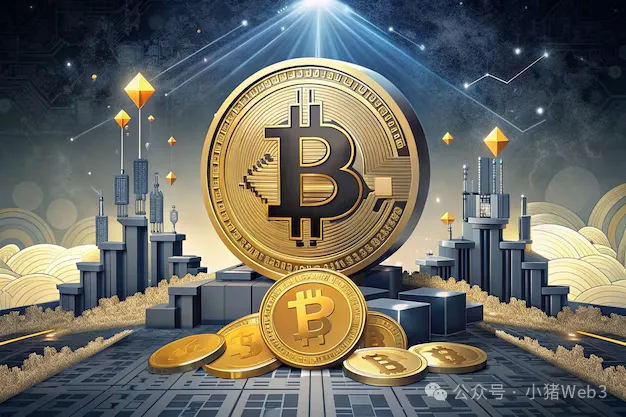Preface

In 2020, I watched a documentary about blockchain technology - "The New Blockchain". This documentary was filmed in 2018, the tenth year of Bitcoin. It tells the important events that have influenced the development and changes of the blockchain industry since the birth of Bitcoin. At that time, the price of Bitcoin was still hovering around US$10,000.
Time flies. In the following years, many things happened in the blockchain industry. It went through cold winter and hot summer, experienced destruction and rebirth. In December 2024, the price of Bitcoin has officially exceeded US$100,000. Its market value surpassed Saudi Aramco and ranked seventh in the global asset ranking, just one step away from Alphabet (Google) in sixth place.
The breakthrough in Bitcoin prices is not only a numerical victory, but also represents an important turning point for cryptocurrency from marginalization to mainstream. This article intends to sort out with readers the development process of Bitcoin from gray to compliant, a general introduction and classification of major cryptocurrencies, and the author’s views on cryptocurrencies.
The development of Bitcoin

On November 1, 2008, an anonymous individual or group known only as Satoshi Nakamoto published a white paper titled "Bitcoin: A Peer-to-Peer Electronic Cash System". Bitcoin solves the problem of issuing and circulating a constant amount of cryptocurrency without any centralized organization by using a public, decentralized ledger (blockchain) and a PoW (Proof of work) ledger synchronization mechanism (consensus mechanism).
On January 3, 2009, Satoshi Nakamoto generated the genesis block in a small server in Helsinki, the Netherlands, and left a sentence on the block, "The Times 03/Jan/2009 Chancellor on brink of second bailout for banks". This marked the official launch of Bitcoin.
On May 22, 2010, a user named Laszlo Hanyecz successfully used 10,000 bitcoins to buy two pizzas by posting a bounty on the Bitcoin Talk forum. This was the first recorded payment using bitcoins. The price of 10,000 bitcoins at the time was about $30, and it is now worth more than $1 billion. It is worth mentioning that the 522 Pizza Festival commemorating this event has become the largest festival in the crypto community.
However, the real use scenario of Bitcoin in the early days was on the notorious dark web, Silk Road. The main trading items on this website were drugs, sex slaves, arms and other illegal transactions, and Bitcoin became the payment tool for these illegal transactions. Data shows that between 2011 and 2013, Silk Road circulated more than 9.5 million Bitcoins, accounting for 80% of the total Bitcoin circulation at the time.
In August 2013, Silk Road was destroyed, and Bitcoin also moved from the dark side to the light side, and began to attract the attention of some early institutions. The landmark event was in September 2013, when Grayscale established the first Bitcoin Trust Fund (GBTC) on the market. GBTC was the only investment product that could be traded in the secondary market of US stocks and tracked the price of Bitcoin at that time. The price of a single Bitcoin was also pushed to $1,242.
This period was also the time when early exchanges sprang up like mushrooms after rain. Mt. Gox became the largest Bitcoin exchange at the time, with an asset management scale of US$4.5 billion, accounting for about 70% of the global Bitcoin trading volume. However, in February 2014, Mt. Gox was hacked, resulting in the theft of 850,000 Bitcoins. Mt. Gox's debt surged and eventually went bankrupt. Affected by this major negative impact, the entire cryptocurrency market collapsed, and the price of Bitcoin fell from US$761 to US$321.
Coinbase is another early exchange that was founded in May 2012. It was invested by Grayscale in 2013 and holds custody of the bitcoin purchased by Grayscale using user subscription funds. Coinbase is now the largest cryptocurrency exchange in the United States by trading volume, and was listed on the Nasdaq in April 2021, becoming the first listed cryptocurrency company in the United States.
On December 11, 2017, the Chicago Mercantile Exchange (CME) launched the world's first Bitcoin futures. The price of Bitcoin also rose sharply to nearly $20,000. In January, the price of Bitcoin was less than $1,000.

Micro Strategy is an enterprise software company engaged in business intelligence solutions. But since August 2020, Micro Strategy has begun to buy Bitcoin on a large scale, becoming the first company on a major U.S. stock exchange to include Bitcoin on its balance sheet. As of now, Micro Strategy has held approximately 440,000 Bitcoins, making it the listed company with the most Bitcoins.
Tesla founder and CEO Elon Musk is also a supporter of cryptocurrency. Tesla invested $1.5 billion in Bitcoin in January 2021. The price of Bitcoin soared to more than $64,000 in April. Although it fell below $20,000 in May due to regulatory crackdowns and other factors. However, it reached $69,000 in November, reaching the high point of the previous bull market.
However, in 2022, with the bankruptcy of FTX, the world's second largest centralized cryptocurrency exchange, the price of Bitcoin fell all the way to $15,500. Tesla also sold 75% of its Bitcoin holdings at the low point of Bitcoin prices.
In January 2024, BlackRock took the lead in promoting the long-awaited Bitcoin spot ETF (IBIT) in the industry. Subsequently, the entire crypto market started a new round of enthusiasm, and the price of Bitcoin, which had been depressed for more than a year, began to break through the US$40,000 mark.
In November 2024, with Trump's victory in the US presidential election, the crypto market was completely ignited, and Bitcoin also ushered in a stronger upward trend, continuously breaking historical highs, reaching as high as US$108,000.
Other major cryptocurrencies

There are many cryptocurrencies, and different cryptocurrency categories may overlap or include each other, so it is difficult to introduce them in just a few lines. Therefore, here we mainly introduce the three categories with the largest market capitalization: Layer1, Meme, and DeFi.
Layer1
Layer1 is another name for the underlying blockchain. Bitcoin, Ethereum (ETH), BNB, Solana, and Sui are typical representatives of Layer1, which is responsible for supporting the infrastructure of the entire ecosystem. Even if Bitcoin is excluded, Layer1 is still the largest category in terms of market value among cryptocurrencies.
In November 2013, Russian-Canadian programmer Vitalik Buterin published a white paper titled "Ethereum: The Next Generation of Smart Contracts and Decentralized Application Platform". Compared to Bitcoin's single cash system function, Ethereum is a decentralized global computer platform that can run smart contracts of any complexity. ETH (Ethereum's native cryptocurrency) is the second largest cryptocurrency in terms of market value after Bitcoin. Ethereum has pioneered the era of smart contracts in blockchain, is the beginning of Web3, and is also one of the only two cryptocurrencies with spot ETFs.
In July 2017, Zhao Changpeng (CZ) launched the cryptocurrency exchange Binance, which has now become the world's largest cryptocurrency exchange. Binance's platform coin BNB is currently the platform coin with the highest market value. BNB can be used to enjoy transaction fee discounts and participate in the issuance of new projects. At the same time, Binance also has an EVM-compatible blockchain called Binance Smart Chain. BNB can also be used as a Gas token on the Binance Smart Chain.
In September 2017, Charles Hoskinson, a former co-founder of Ethereum, launched the PoS blockchain Cardano (ADA). Charles left in 2014 due to disagreements with Vitalik, also a co-founder of Ethereum, and started to develop Cardano. The purpose of Cardano is to solve the shortcomings of Ethereum, including interoperability, scalability and sustainability. Cardano is known as the first generation of "Ethereum killer".
In November 2017, former Qualcomm engineer Anatoly Yakovenko published the Solana white paper, introducing "Proof of History" (PoH) - a mechanism for keeping time between untrusted computers. With PoH, Anatoly set out to build Solana (SOL), aiming to achieve a high-performance Layer1 whose software scales at the speed of hardware. Solana is not only the most successful "Ethereum killer", but has also become a representative of high-performance Layer1. Compared with Ethereum, Solana sacrifices some decentralization, but its performance has been improved by a hundred times.
In September 2021, Sam Blackshear, Adeniyi Abiodun, and George Danezis, former senior engineers of Facebook (now Meta)'s encryption department, founded Mysten Labs and launched Sui, a high-performance Layer1, in August of the following year. Sui uses its own customized version of the Move language to write its smart contracts, using an object-based data model that allows independent objects to process transactions in parallel. This design enables Sui to achieve high throughput and low latency. Sui grew rapidly in 2024 and was called the "Solana killer."
Meme
Meme coin is also a digital asset that has attracted much attention in the field of cryptocurrency. Meme is more like a symbol of a cultural phenomenon, combining humor, creativity and social interaction.
On December 6, 2013, programmers Jackson Palmer and Billy Markus were inspired by the popular Shiba Inu "Doge" emoticon on the Internet and created Dogecoin (DOGE). Palmer and Markus's original idea was just to make a lighthearted and fun cryptocurrency to poke fun at the exaggeration and hype in the cryptocurrency circle at the time, without considering its actual use. Dogecoin is not only the first Meme coin, but also Elon Musk's favorite cryptocurrency.
Representative projects of Meme Coin include SHIB and PEPE tokens on Ethereum, and BONK tokens on Solana, etc. I will not introduce them in detail here.
DeFi
DeFi (Decentralized Finance) refers to an ecosystem of financial applications running on blockchains, which are usually not controlled by any central authority or intermediary. Instead, they use smart contracts on decentralized networks to execute and be bound by the terms of transactions, enabling users to complete transactions directly without the involvement of traditional financial institutions.
In the summer of 2020, the DeFi project exploded on Ethereum, all key indicators of the blockchain market have been significantly improved, and the entire cryptocurrency market value has increased by nearly 100 times. It can be said that DeFi is currently the biggest innovation in the blockchain application layer.
DeFi projects can be further divided into stablecoins, decentralized exchanges (DEX), lending, etc.
Stablecoins are divided into centralized stablecoins (such as USDT, USDC, etc.) and decentralized stablecoins (such as MakerDAO (MKR)/DAI, ENA/USDe, etc.). As the name suggests, stablecoins are anchored to fiat currency (mainly US dollars) and maintain a 1:1 exchange ratio.
DEX is represented by Uniswap (UNI) and Curve (CRV). Uniswap is the largest DEX on Ethereum, launched in November 2018. In 2023, Uniswap's trading volume exceeded US$450 billion, accounting for about half of the entire DEX trading market, and even exceeded the spot trading volume of Coinbase, the largest exchange in the United States.
Lending is represented by AAVE and Compound (COMP). AAVE is one of the largest lending projects on Ethereum, launched in November 2017. AAVE is a lending pool system that enables users to choose to borrow, lend, and earn interest on dozens of different cryptocurrencies without the need for a middleman. AAVE has not had any major security incidents so far.
Summarize

When many people mention cryptocurrency, they think of it as a disaster or a casino scam. But it is almost 2025 now, and Bitcoin has exceeded $100,000. We should look at cryptocurrency with a new perspective.
First of all, for most mainstream cryptocurrencies, it is already a highly liquid and high-value asset. Among them, Bitcoin will be included in the balance sheets of more companies in the future, and will even be listed as a reserve asset of some countries.
Secondly, cryptocurrency projects can be seen as early-stage startups, Layer1 as SaaS companies, Meme as trendy brands, and DeFi as financial companies. Cryptocurrencies have voting rights for projects, and some can even generate interest, which can be compared to company stocks. However, issuing cryptocurrency is not like stocks. It takes a long time to be reviewed before it can be listed. The threshold for issuing cryptocurrency is low. Project parties can issue it directly after designing the cryptocurrency economic model. Therefore, it has a higher risk and speculation is particularly prevalent.
Finally, Web3 is a technological revolution in human history. Cryptocurrency is both its component and its side effect. There may be financial bubbles in cryptocurrency, but bubbles always revolve around transformative technologies. We can look at the development of Web3 and cryptocurrency more tolerantly.
In the world of Web3, you can be an investor, a KOL, a freeloader, a developer, or just a witness. The market has greed and fear, and human nature has meanness and nobility. The era of Web3 adventure has begun. There are shadows in the sunshine of the era, and those who are unwilling to take risks are not in the sunshine.













